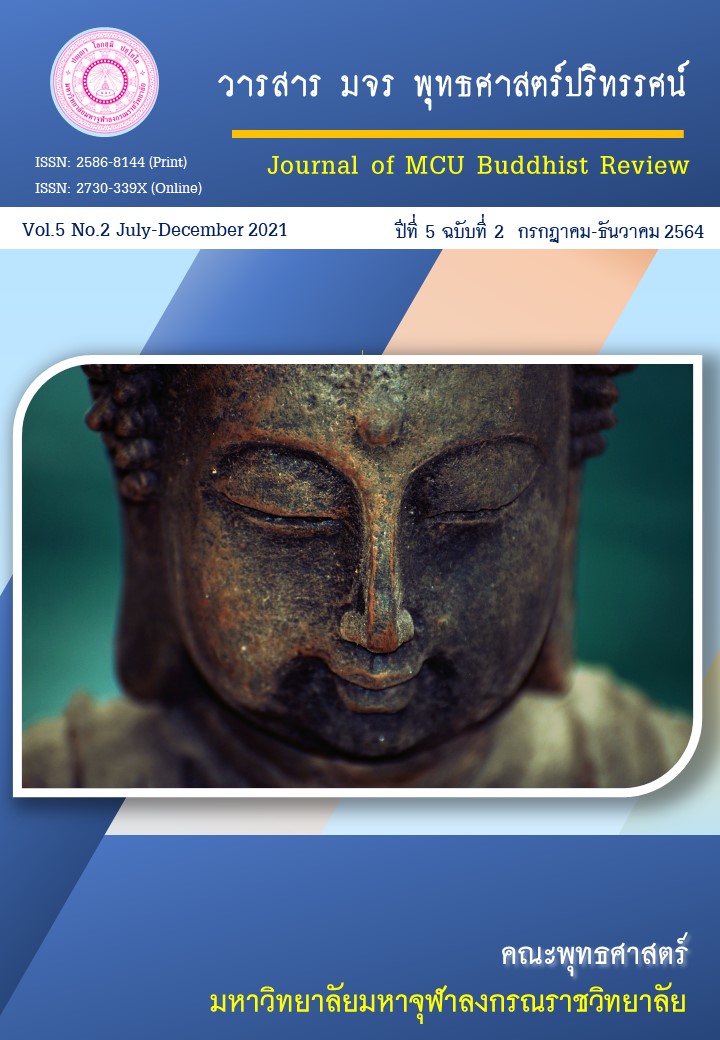ความเชื่อและพิธีกรรมของศาลเจ้าจีนไต้หวัน: กรณีศึกษา ศาลเจ้ามูลนิธิธรรมกตัญญู (เสียนหลอไต้เทียนกง) จังหวัดสมุทรปราการ
Main Article Content
บทคัดย่อ
การวิจัยนี้มีวัตถุประสงค์เพื่อศึกษาความเชื่อและพิธีกรรมที่อยู่ในศาลเจ้ามูลนิธิธรรมกตัญญู (เสียนหลอไต้เทียนกง) จังหวัดสมุทรปราการ ซึ่งเป็นงานวิจัยเชิงคุณภาพที่ศึกษาข้อมูลจากเอกสารและใช้วิธีเก็บข้อมูลภาคสนามด้วยการสัมภาษณ์จากผู้ที่เกี่ยวข้องกับศาลเจ้ามูลนิธิธรรมกตัญญู (เสียนหลอไต้เทียนกง) จำนวน 30 คน และการสังเกตการณ์ นำข้อมูลที่ได้มาศึกษาวิเคราะห์และนำเสนอผลการวิจัยแบบพรรณนาวิเคราะห์ ผลการวิจัยพบว่า ศาลเจ้ามูลนิธิธรรมกตัญญู (เสียนหลอไต้เทียนกง) มีประวัติศาสตร์ที่ยาวนานและเป็นศาลเจ้าที่มีความศักดิ์สิทธิ์ โดยมาจากศาลเจ้าหนานคุณเซินไต้เทียนฟู่ที่ไต้หวัน ซึ่งการสร้างศาลเจ้าแห่งนี้ในจังหวัดสมุทรปราการนั้นมีเหตุมาจากความเชื่อและความศรัทธาที่มีต่อเทพเจ้าหวูฝู่เชียนส้วยของชาวจีนไต้หวันศาลเจ้าแห่งนี้ยังคงมีความเชื่อที่สะท้อนให้เห็นถึงวัฒนธรรมจีนไต้หวันอย่างชัดเจนมีอยู่ 8 ประการ ได้แก่ ความเชื่อเรื่องสุขภาพ ความมั่นคงของชีวิต ดวงชะตา ความเมตตา การค้าขาย การขอโชคลาภเงินทอง การขอบุตร และการงาน จากความเชื่อดังกล่าวจึงมีพิธีกรรมที่สำคัญจำนวน 5 พิธีกรรม คือ 1) การแก้ปีชง 2) วันตรุษจีน 3) วันเทศกาลหยวนเซียว 4) งานวันเกิดของเทพเจ้า 5) งานเทกระจาดประจำปี ถึงแม้ว่าความเชื่อและพิธีกรรมของศาลเจ้าแห่งนี้มีการเปลี่ยนแปลงไปจากอดีต แต่การประกอบพิธีกรรมนั้นก็ยังคงมีการสืบทอดความเชื่อเหล่านี้ให้คงอยู่ในปัจจุบัน
Article Details
- บทความที่ได้รับการตีพิมพ์เป็นลิขสิทธิ์ของวารสาร มจร พุทธศาสตร์ปริทรรศน์
- ข้อความใดๆ ที่ปรากฎในบทความที่ได้รับการตีพิมพ์ในวารสาร ถือเป็นความรับผิดชอบของผู้เขียนบทความ และข้อคิดเห็นนั้นไม่ถือว่าเป็นทัศนะและความรับผิดชอบของกองบรรณาธิการวารสาร มจร พุทธศาสตร์ปริทรรศน์
เอกสารอ้างอิง
กุลศิริ อรุณภาคย์. (2553). ศาลเจ้า ศาลจีนในกรุงเทพ. กรุงเทพมหานคร: มิวเซียมเพรส.
ท่านประธานคณะกรรมการมูลนิธิหนานคุณเซินไต้เทียนฟู่. (2537) อัลบั้มของเสียนหลอไต้เทียนกงที่ประเทศไทย. เมืองไถหนาน: หลิงเว่ย พริ้นติ้ง บจก.
ท่านประธานคณะกรรมการมูลนิธิหนานคุณเซินไต้เทียนฟู่. (2555) การก่อสร้างอาคารศาลเจ้า ซุ้มประตูและพิพธภัณฑ์ ณ ศาลเจ้ามูลนิธิธรรมกตัญญู (เสียนหลอไต้เทียนกง). เมืองไถหนาน: วัฒนธรรมต้าเฉิงเป่ย
ต้วน ลี่ เชิง และบุญยิ่ง ไร่สุขสิริ. (2543) ความเป็นมาของวัดจีนและศาลเจ้าจีนในประเทศไทย. กรุงเทพมหานคร : คณะกรรมการศาสนาเพื่อการพัฒนา.
พจนานุกรมฉบับราชบัณฑิตยสถาน. (2542). กรุงเทพมหานคร : นานมีบุ๊คส์พับลิเคชั่นส์.
HE ZHONGHUAN. (2563). ความเชื่อและพิธีกรรมของศาลเจ้ากวนอูในพื้นที่กรุงเทพมหานคร: กรณีศึกษาฝั่งธนบุรี. สาขาวิชาการสื่อสารภาษาไทยเป็นภาษาที่สอง. คณะศิลปศาสตร์ มหาวิทยาลัยหัวเฉียวเฉลิมพระเกียรติ.


